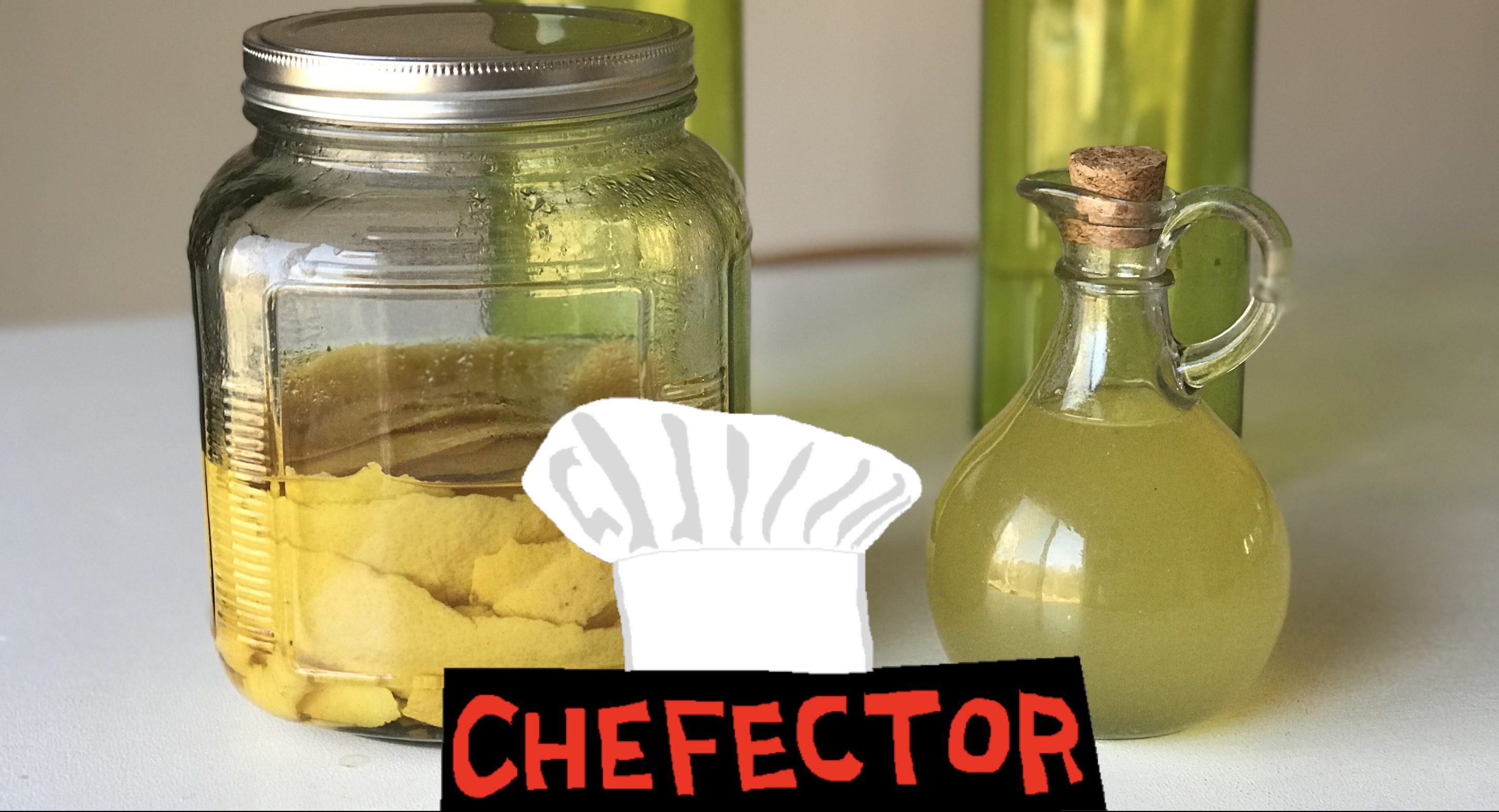Let’s Make Some Delicious Limoncello, For It Is Limoncello Time
9:01 AM EST on March 11, 2021

Lemons are in season, did you know? In fact that is a trick question, for in places where lemons grow it is always lemon season. But in places where lemons will not grow, what makes it lemon season is that it is getting warmer outside, day by day, and lemons are a nice thing to enjoy in warm weather. Anyway that is as much thrashing around for an excuse to make limoncello as I am going to get into. It is time to make limoncello.
Limoncello is an Italian liqueur made from high-proof neutral booze and lemons, and sweetened with sugar. You can buy it by the bottle. Lots of fancy bars will make their own, because the fresh stuff is best. Your home is not a fancy bar, but why should you not enjoy the pleasure of fresh, bright, wonderful limoncello, suited exactly to your own tastes? Already I feel stupid for having done yet more thrashing about. Listen. We are making limoncello today. I have a particular way of doing it, and it is good, and you will be enriched for having joined me. It's simple and cheap and at the end you will have something in your kitchen that just rules so much. Sometimes you work long and hard at complex processes to produce things that rule very much. This time you will work a little bit at the kind of tasks that a not-particularly-good dog could manage, if it had opposable thumbs, and at the end the thing you make will rule very, very much. People who taste it will do that thing where they nod their head and frown but in a way that communicates admiration, once they learn you made it yourself, in your own kitchen.
Obviously you will need some lemons. Just as obviously, you will need some booze. Somewhat less obviously (but still pretty obvious!), you will need some regular granulated sugar. And you will need two reasonably large vessels that can be sealed at the top. Two of those large-size Ball jars with the screw-top lids would be great; two deep glass or plastic tupperware-type deals with their own lids would work; you could even just rubber-band some plastic wrap over the mouths of, I don't know, some big pitchers or vases. What matters is that you have two glass or plastic vessels capable of holding a full bottle's worth of booze with room to spare. One you are going to fill with a full bottle's worth of booze, and the other you are going to fill with delicious syrup. Oh, and you will need a big sealable bottle or two, for the finished product.
You will need a lot of lemons for this project. When I say "a lot," what I mean is so many that the cashier at the grocery store is going to remark upon your huge bag of lemons. You are going to use no fewer than 15 lemons for the booze-infusing part of your limoncello project, and you are going to use another 12 lemons for the syrup. And, to make matters worse, you are not going to be able to take a shortcut and just buy a couple of those little pre-sorted sacks of lemons. You are going to have to stand there at the big lemon bin in the produce department, carefully selecting one lemon at a time, until you have counted out 27 lemons and there is a crowd of shoppers gathering around you, pointing and murmuring worriedly, several of them taking cell-phone video. Turn away from the lemon bin slowly in an erect posture, give the alarmed onlookers a not-at-all winning mouth smile, and say, "Sorry, folks, just had a hankering for some lemons." Then walk away without another word.
There is a good reason for you to select the lemons in this way. We are looking for specific characteristics, here. You want a medium to large lemon with no green or other discoloration on the peel, and when you handle the lemon you want the peel to feel thick and firm under your fingers. The grab-bag lemons in the little sacks are just a random assortment, tumbled into bags by some big conveyor belt or something. Who knows how long they've sat there. No. We want fresh, bright, firm, mighty lemons, and we want twenty-damn-seven of them. It is probably true that these hand-selected lemons will taste better and lemonier than shitty little shriveled lemons from the sack, but that is not why you need them. You need them because hefty fresh lemons with bright, thick, unblemished peels will be vastly, vastly easier to peel. And buddy, you are going to be doing so much peeling.
This ends up being not all that torturous a process, in the end. Get home, give the lemons a good rinse, and get 15 of them into a pile on and around your cutting board, next to one of those big vessels. Now, grab up your trusty vegetable peeler and get to work. There's no reason to be super committed to peeling each lemon in big curly strips. The main thing is, you want to try as much as possible to peel the yellow outermost rind from the lemon while leaving behind the white pith that sits just below the surface. The yellow surface rind is almost shockingly rich with bright lemony taste and aroma, but the pith is mostly bitter and gross, and if a bunch of it makes its way into your limoncello, you are going to notice. Peel carefully!
Inevitably, you are going to wind up with pith on some or all of your peels. It's fine! I like to keep a small sharp knife handy, so that I can plunge it into my jugular vein as soon as this task becomes too tedious. But before that final moment it is useful for scraping the pith off of your lovely little strips of peel. This sounds miserable, and is, but it is at least a little bit less miserable than it sounds. Pin the peel to the cutting board with one hand, so that the pith is facing up, with the other hand holding the knife perpendicular to the flat surface. Picture an ice-scraper moving across the windshield of your car, where the yellow is the windshield and the white is ice. Do that with the blade of the knife, to the lemon peel. You'll get the hang of it, and there's a very good chance you will not cut too many of your fingers off along the way. Work in this way for a while, using the peeler to strip each lemon, then using the knife to scrape off the pith, and then throwing the scraped strips of peel into the vessel. It will take some time but it will be rewarding and cathartic and at the end your hands will smell just great.
This process will leave you with a vessel full of glistening lemon peels, a cutting board smeared with little white blobs of pith, and a huge pile of peeled lemons. Do whatever you want with the lemons. I squeezed some of them into a little tupperware deal and used the juice to make lemon bars, and the rest I chucked into the backyard. The pith goes in the trash. As for the jar of peels, you are going to empty into that sucker one full bottle of booze.
You've got some options, booze-wise, but not very many. If you can track down a bottle of 190-proof neutral grain spirit—think Everclear, here—that will work very well: Everclear will not compete with the lemon for flavor supremacy, because it is neutral, and you will be able to sock your limoncello away in the freezer for a long time, because the alcohol content will be high enough to prevent freezing. On the flip side, it will make your concoction powerfully, overwhelmingly boozy, even after it's been diluted with syrup, and that's just not everyone's bag. If you live in a place where it's hard to track down Everclear, or if you'd prefer a less intense limoncello, you can opt for vodka. Standard vodka in the U.S. is usually 80-proof—40 percent alcohol by volume—but can go all the way up to 151-proof. Limoncello made with 80-proof vodka will be smooth and sweet and delightful, but you will not be able to store it in the freezer, because the be-syruped finished product may turn to ice in the bottle, and that would be bad. No one wants that.
Probably your best bet is to look for a bottle of a higher-proof vodka, which will make a somewhat less intense limoncello than a batch made with Everclear, but will also survive the freezer. I recently made a batch using 80-proof neutral moonshine, because I happened to have a full bottle of moonshine and no earthly idea what to do with it. And it's fine, even if it will have to live out its short life in the fridge. Whatever you opt for, get a big bottle of the stuff, and empty the booze into the vessel with the lemon peels. Now, use a wooden spoon or rubber spatula or whatever to push the peels down into the booze, then seal up the vessel, sock it away in the refrigerator, and forget about it for 10 whole days. If you should notice the vessel in the fridge here and there, and should feel compelled to give it a shake or a swirl or a sniff, go for it. Cool stuff is happening in there: The booze is soaking the lemon scent and flavor out of the peels, and each time you check on it, it's noticeably more infused. It feels sort of alchemy-ish, watching the booze turn yellow and observing the way the strong lemon aroma rises to meet and eventually overpower the nasal burn of high-test alcohol. It's mellowing, somehow! Which is neat because "mellow" is a word that rhymes with "yellow."
After nine days the booze will be extremely urine-colored, and you will be ready to proceed to the final step of limoncello making. You've got two choices, here: You can combine two cups of sugar with one cup of water in a saucepan over low heat, wait for the sugar to melt, and use this heavy simple syrup as the sweetener for your limoncello; or, you can be bold and heroic and use SCIENCE to make lemon syrup, which will make your limoncello the lemoniest liqueur in all the land. The simple syrup option is the standard way, and will be fine; the lemon syrup option is the Chris Thompson Special, and it is simply better.
This really could not be simpler. Remember the 12 lemons you did not use for infusing the booze? Grab these leftover lemons, cut them in half, and juice them, either into a small bowl of some sort or into the kitchen sink or into your open mouth, I don't care! Next, cut each juiced lemon half into quarters, so that you have a huge pile of chopped-up lemons in front of you. Grab up your second large vessel—I distinctly remember saying you would need two large vessels—and drop into it a big handful of lemon chunks. You are going to layer handfuls of lemon chunks with hefty scoops of sugar in this large vessel, jamming and smashing the lemon chunks down the whole while, until you have roughly two cups of sugar in there and as much lemon action as the jar will handle. Now, screw the lid on there and give the whole thing a good shake. You are doing science right now!
Lemons, you see, contain citric acid, and this acid is plenty powerful enough to melt granulated sugar at room temperature. It will take a few hours, and you will need to check in and shake this vessel let's say every half-hour to hour, at least until the science in the vessel has caused the lemon chunks to soften and sag, but before long—certainly by the morning of Day 10, which is Limoncello Day—all the sugar in the vessel will have melted and you will have a cloudy, intensely lemony sugar syrup in the bottom third or so of your vessel. Neat! Delicious and neat.
The day has arrived, and it is time to combine the liquid contents of Vessel One with the liquid contents of Vessel Two. I have found that a good way to do this is to pour the lemony booze through a coffee filter or mesh strainer or colander into one of those flimsy plastic to-go containers they use for phó broth, which are flexible enough for precision pouring into the smaller mouth of a wine bottle. For the syrup, you will want to filter it through a fine mesh strainer, but it is also fine to just reach in there with a slotted spoon and haul out the lemon chunks, taking the time to smash them against the side of the vessel on their way out so that they release the maximum amount of sweet, sweet syrup. One way or another, once you have the filtered booze and the filtered syrup, simply combine the two and then pour the resulting mixture into your bottle[s] of choice. You can taste your way through this, but there's a good chance you will be tasting your way to a state of profound inebriation, so be careful! Or not. Either way, you're finished!
Look at what you have done. You have stocked your home with a large quantity of delicious, fantastic-smelling, and quite lovely homemade liqueur. If you used simple syrup and 100-proof or higher booze, your limoncello will live in the freezer for a long time, provided you can talk yourself out of chugging it, which may be a challenge. If you made it with lower-proof booze and lemon syrup, I truly do not know how long your limoncello will keep. The lemon juice—itself an old-timey preservative—probably spoils before very long, and the lower-proof booze will turn to ice in the freezer, potentially rupturing the bottle and ruining everything. The reason I can't tell you how long this stuff will keep in your fridge is because with the lemon syrup and the smoother booze it is simply way too delicious to survive in my refrigerator for more than a couple weeks. I can tell you that it will be fine and tasty for two weeks. Probably longer.
Limoncello demands a bright warm day, and by God there are plenty of those on the way. Winter is drawing to a close. Crocuses are popping, daylight savings is around the corner, nightmare broods of biblical proportions are digging their way out of the ground at your feet. Take a small clear glass and your sweating bottle of limoncello out into the sun, have a seat somewhere comfortable, pour yourself a small portion, and sip. Here you are, you made it.
If you liked this blog, please share it! Your referrals help Defector reach new readers, and those new readers always get a few free blogs before encountering our paywall.
Staff Writer
Read More:
Stay in touch
Sign up for our free newsletter




